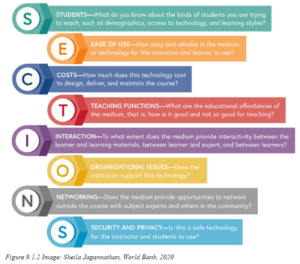First, I would like to thank everyone who replied to my last post, “Equity In On-Line Learning.” The quote from the Yukon News gave me pause, which is why I wanted to share it. I would also like to share this TedTalk as it helps to reframe the word “disabled”
I have reflected on my Early Learning course and how I can make it more accessible and equitable for my students. I appreciate the Sections model from the Bates (2019) and will use it as a guide in critiquing my course.

STUDENTS:
The students in my courses are adults, women and culturally diverse. They also all live in rural Yukon communities. The learning styles of the students are varied. Some students are very confident and engage in the learning. Some students are very hesitant and will not turn on their camera. Some students were not successful when they were students and it is emotionally hard for them to join. Just showing up is a risk. I think about those students when thinking about accessibility and equity. The students need to be pass the course so they can continue with their employment. The young children in their care need educators who are trained and able to meet their needs. I must ensure the course material is accessible to the students. The best way to achieve this is to make connections and build a relationship with them. This, of course, takes time. It also takes a suite of tools in my teaching toolkit.
EASE OF USE:
This section of the model focuses on how easy is it for the educator and students to use the technology. I have to use Moodle, there is no choice with this platform. How I choose to use it is up to me. The issue of reliability considered in this section. I also have no control over that, and neither do the students. We can connect to the Internet and meet through Zoom or we can’t. It is quite rare that there are issues with connectivity, which is positive.
COSTS:
Most of my students join the synchronous classes from their home. The students pay for their Internet access. Some students can not join from their home and they go the YukonU campus in their community. They do not have to pay to use the Internet if they chose to go to the campus. Most communities do not have unlimited Internet use and Internet packages can be expensive. It also depends on how many people live in each household and how much the Internet is used. This was a bigger issue during COVID when kids had to use online learning for school. Some of my students would run out of data and overage charges are expensive.
TEACHING FUNCTIONS:
This section required me to reflect on the use of Moodle; is it good or not so good for teaching. Moodle is a tool and it is as good as how the educator chooses to use it. My goal with online teaching in to create relationships and connections in spite of the barrier of the computer screen. I use breakout rooms and interactive apps like Jamboard as much a possible. Power point presentations or long blocks of the class with me talking are to be avoided as much as possible.
INTERACTION:
I have found that students are more likely to engage with the large group (and turn on their camera) if they first have made connections with small groups of students. I am always looking for ways to do this piece better. Classes such as this one helps as I am shown new teaching functions, and how to use them to improve the way I use Moodle. This aids accessibility as hopefully the classes are more engaging and interceding for the students.
ORGANIZATIONAL ISSUES:
The short answer to this section is yes! My learning institution only uses Moodle. I am often given a sandbox with the shell of my course already in it. I add information and move topics around to best suite my teaching and the students learning.
NETWORKING:
This section asks if their are opportunities to network with experts and community members. The students and I met though Zoom for our courses and there are many opportunities to network with others. The networking would not be possible without Zoom because of the distances between communities in he Yukon. In this regard, learning has been enhanced because of technology.
SECURITY AND PRIVACY:
This section poses the question if the technology is safe for the instructor and students to use. I sure hope so! I enable the waiting room function so I can control who enters the Zoom meetings. Beyond this, I have no control. I do not know if my learning institution uses a cloud service provider and if so, which one. I hope the information is stored in Canada but I have never asked. I am thinking that I should!
CONCLUSION:
Bates (2019) suggests that educators start with their intuition when thinking about technologies to use in their teaching. He also suggests keeping an open mind. I agree with him on both points. It is very easy to fall into a rut when teaching, particularly when teaching the same course over and over. It is also very challenging to keep up with technology as it changes so quickly. There always seems to be a new app to try. My goal is to keep my mind open and choose technology that will build relationships and create connections with my students.
